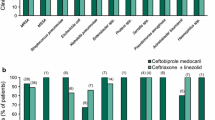Abstract
In an open, prospective, randomised study, the clinical and bacteriological efficacy of intravenously administered clarithromycin was compared with that of amoxicillin-clavulanic acid in 112 patients with community-acquired pneumonia requiring hospitalisation. Clinical cure or improvement occurred in 86% (48/56) of the clarithromycin-treated patients and 84% (47/56) of the amoxicillin-clavulanic acid-treated patients. The rate of bacteriologie eradication was similar for the two drugs as were the rapidity of a clinical response and the rate of improvement of radiological signs. Clarithromycin had a slightly higher rate of side-effects mainly due to phlebitis caused by the intravenous treatment, but treatment could be continued in all cases. Clarithromycin should be used with caution in patients being treated with digoxin because of a significant risk of bradycardia resulting from drug interaction.
Similar content being viewed by others
References
Garibaldi RA: Epidemiology of community-acquired respiratory tract infections in adults. American Journal of Medicine 1985, 78, Supplement 6B: 32–37.
Meyer RD, Finch RG: Community-acquired pneumonia. Journal of Hospital Infections 1992, 22, Supplement A: 51–59.
The British Thoracic Society: Guidelines for the management of community-acquired pneumonia in adults admitted to hospital. British Journal of Hospital Medicine 1993, 49: 346–350.
Niederman MS, Bass JB, Campbell GD: Guidelines for the initial management of adults with community-acquired pneumonia: diagnosis, assessment of severity, and initial antimicrobial therapy. American Review of Respiratory Diseases 1993, 148: 1418–1426.
Regamey C: Aspect des pneumonies infectieuses acquises en dehors de l'hôpital. Médecine et Hygiène 1989, 47: 289–293.
Bohte R, van't Wout JW, Lobatto S, Blussé van Oud Alblas A, Boekhout M, Nauta EH, Hermans J, van den Broek PJ: Efficacy and safety of azithromycin versus benzylpenicillin or erythromycin in community-acquired pneumonia. European Journal of Clinical Microbiology & Infectious Diseases 1995, 14: 182–187.
Kinasewitz G, Wood RG: Azithromycin versus cefaclor in the treatment of acute bacterial pneumonia. European Journal of Clinical Microbiology & Infectious Diseases 1991, 10: 872–877.
Neu HC, Chick TW: Efficacy and safety of clarithromycin compared to cefixime as outpatient treatment of lower respiratory tract infections. Chest 1993, 104: 1393–1399.
Bartlett JG, Mundy LM: Current concepts. Communityacquired pneumonia. New England Journal of Medicine 1995, 333: 1618–1624.
Donowitz GR, Mandell GL: Acute pneumonia. In: Mandell GL, Bennett JE, Dolin R (ed): Principles and practice of infectious diseases. Churchill Livingstone, New York, 1995, p. 619–637.
Breiman RF, Butler JC, Tenover FC, Elliott JA, Facklam RR: Emergence of drug-resistant pneumococcal infections in the United States. Journal of the American Medical Association 1994, 271: 1831–1835.
Barry AL, Jones RN, Thornsberry C: In vitro activities of azithromycin (CP 62,993), clarithromycin (A-56268), erythromycin, roxithromycin and clindamycin. Antimicrobial Agents and Chemotherapy 1988, 32: 752–754.
Blatter M, Fabbri J, Frei R: Kulturell dokumentierte Legionellen-Infektionen im Zuweisungsgebiet des Bakteriologielabors, Kantonsspital Basel. Schweizerische Medizinische Wochenschrift 1996, 126, Supplement 74/II: 333.
Vogel F: Sequential therapy in the hospital management of lower respiratory infections. American Journal of Medicine 1995, 99, Supplement 6B: 14–19.
Weingarten SR, Riedinger MS, Varis G, Noah MS, Meyer RD, Ellrodt AG: Identification of low-risk hospitalized patient with pneumonia: Implications for early conversion to oral antimicrobial therapy. Chest 1994, 105: 1109–1115.
Bates JH, Campbell G, Barron AL, McCracken GA, Morgan PN, Moses EB, Davis CM: Microbial etiology of acute pneumonia in hospitalized patients. Chest 1992, 101: 1005–1012.
Woodhead MA, Macfarlane JT, McCracken JS: Prospective study of the etiology and outcome of pneumonia in the community. Lancet 1987, i: 671–674.
Moine P, Vercken JB, Chevret S, Chastang C, Gajdos P: Severe community-acquired pneumonia: Etiology, epidemiology and prognosis factors. Chest 1994, 105: 1487–1495.
Author information
Authors and Affiliations
Rights and permissions
About this article
Cite this article
Genné, D., Siegrist, H.H., Humair, L. et al. Clarithromycin versus amoxicillin-clavulanic acid in the treatment of community-acquired pneumonia. Eur. J. Clin. Microbiol. Infect. Dis. 16, 783–788 (1997). https://doi.org/10.1007/BF01700406
Issue Date:
DOI: https://doi.org/10.1007/BF01700406




